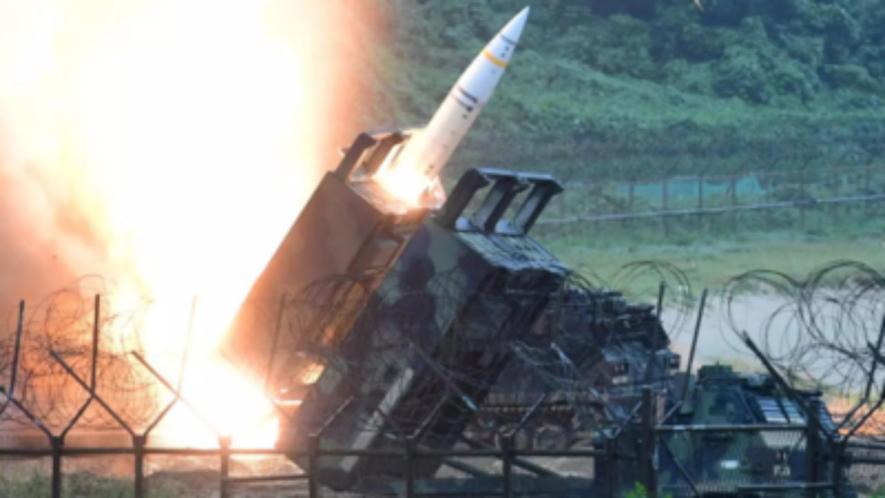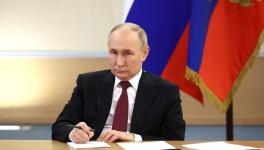Ukraine: US Doubles Down, Russia is Cool

US to transfer ATACMS system to Ukraine with 300 km range
Russia’s free running in the Ukraine war in the most recent months is about to end as the Joe Biden Administration has met with success, finally, in the US Congress on the long-stalled Ukraine aid Bill. The aid approved by the House on Saturday would send $60.8 billion to Ukraine.
Senate approval is expected as soon as Tuesday. President Biden has promised, “I will immediately sign this law to send a signal to the whole world: we support our friends and will not allow Iran or Russia to succeed,”
To be sure, the US is doubling down to frustrate Russia’s perceived plans for an outright Russian military victory in Ukraine through this year. Unsurprisingly, Washington’s transatlantic allies are also rallying, which is the message coming out of the virtual meeting of the NATO-Ukraine Council at the level of Allied Defence Ministers chaired by Secretary-General Jens Stoltenberg at Brussels on Saturday.
The sense of relief in Kiev is palpable with President Volodymyr Zelenskyy telling NBC, “I think this support will really strengthen the armed forces of Ukraine, and we will have a chance for victory.” He said the US lawmakers moved to keep “history on the right track.”
On the other hand, the Russian foreign ministry reaction has been rather polemical — as if Moscow was anticipating the development. What seems to perturb Moscow most in the US aid bill is the thinking favouring the confiscation of frozen Russian assets to fund Ukraine, which, the Kremlin spokesman Dmitry Peskov singled out “because this is essentially the destruction of all the foundations of the economic system. This is an encroachment on state property, on state assets and on private property. By no means should this be perceived as legal action — it is illegal. And accordingly, it will be subject to retaliatory actions and legal proceedings.”
Moscow would sense that the American intention is, first, to force the EU too onto a similar trajectory and thereby destroy whatever residual prospects remain for reconciliation between Russia and Europe for a long time to come; second, provide the wherewithal to ultimately utilise the Russian frozen assets to generate business for the US military-industrial complex; and, three, in geopolitical terms, create a precedent in any future showdown between the West and China.
Suffice to say, Moscow is right in estimating that in a longer term perspective, the 21st Century Peace through Strength Act, which was also passed by the US House of Representatives with a bipartisan vote of 360-58 on Saturday empowering empowering the US executive branch to seize and transfer frozen Russian assets held in the US to Ukraine is fraught with consequences far more devastating than the $60 billion financial aid for Ukraine. Curiously, they complement each other too.
Make no mistake about the bipartisan consensus in the Congress in this regard. This is important to know as Donald Trump has apparently shed his ambivalence and decided to be supportive of the Ukraine aid bill. The meeting between Trump and the Republican House speaker Mike Johnson in the run-up to the vote in the House on Saturday would suggest that Johnson might not be ousted, after all, by his far-right House Republican colleagues.
Beijing understands the diabolical play perfectly well. A commentary in the Global Times on Sunday said, “If the bill [on Russian assets] ultimately becomes law and goes into effect, it will set a disastrous precedent against the existing international financial order.”
Of course, the Russian military moves going forward will be keenly watched. For, in such fluid circumstances, actions will speak better than words. At any rate, an inflection point has come since, evidently with an eye on Russian President Vladimir Putin’s forthcoming visit to Beijing, the Biden Administration is also shifting gear to explicitly threaten China for allegedly supporting the Russian defence industry. The US Secretary of State Antony Blinken is paying a 3-day visit to China on Wednesday.
Taken together, what emerges is that the Biden Administration is doubling down on the Ukraine war, contrary to earlier prognosis that war fatigue is setting in. Meanwhile, Pentagon spokesperson Maj. Gen. Pat Ryder has disclosed to Politico in a statement that the Biden Administration is considering sending additional military advisers to Ukraine, since “security conditions have evolved.”
These additional personnel “would not be in a combat role, but rather would advise and support the Ukrainian government and military.” The specific numbers of personnel remain confidential “for operational security and force protection reasons.” They will support logistics and oversight efforts for the weapons the US is sending Ukraine and “new contingent will also help the Ukrainian military with weapons maintenance.”
Indeed, the sophistry of non-combat role apart, what is in the cards is an incremental expansion of the US military presence in Ukraine, notwithstanding Biden’s repeated assertions that US troops wouldn’t participate in the war on Ukraine’s behalf, as doing so would increase the risk of a direct Russian-American military confrontation.
Citing sources, Politico further reported that “One of the tasks the advisers will tackle is helping the Ukrainians plan sustainment of complex equipment donated by the US as the summer fighting is expected to ramp up.”
How does the new $60.75 billion aid package add up? It includes $23.2 billion intended to replenish US weapons stocks; $13.8 billion for the purchase of advanced weapons systems for Ukraine; and another $11.3 billion for “ongoing US military operations in the region.”
That is to say, in effect, the direct military assistance to Ukraine will actually amount to about $13.8 billion till end-2024. The Russian experts estimate that this allocation rules out another Ukrainian “counteroffensive.” But that is small comfort, since the increased flow of US weaponry will beef up the Ukrainian military capability to withstand the Russian offensive, which cannot but impact the present balance of forces at the front.
From a military angle, in immediate terms, the cutting edge of the aid bill lies in the fact that it opens the gateway for the transfer to Ukraine of tactical missile systems [ATACMS] capable of hitting targets at a distance of up to 300 km, which brings Crimea within its range. Reportedly, French troops are already on the ground in Odessa numbering 1000 and another contingent is expected shortly. This was, of course, forecast a few weeks ago by the Russian foreign intelligence but Paris had flatly denied it. (here and here)
The bottom line here is that the aid package aims on the one hand to avoid a catastrophic military situation arising at the front in the coming months, which could be politically damaging for Biden’s re-election bid, while on the other hand, the bulk of funds actually goes to the US arms manufacturers in some key “swing states” and gratifies the influential military-industrial complex and the Deep State.
Biden told Wall Street Journal, “We will send military equipment from our own stocks, and then use the money authorised by Congress to replenish these stocks by buying them from American suppliers. This includes Patriot missiles made in Arizona, Javelin missiles made in Alabama, and artillery shells made in Pennsylvania, Ohio and Texas.”
To be sure, the triumphalist narrative of the Ukraine war by the US state department is on a comeback trail.
MK Bhadrakumar is a former diplomat. He was India’s Ambassador to Uzbekistan and Turkey. The views are personal.
Courtesy: Indian Punchline
Get the latest reports & analysis with people's perspective on Protests, movements & deep analytical videos, discussions of the current affairs in your Telegram app. Subscribe to NewsClick's Telegram channel & get Real-Time updates on stories, as they get published on our website.
























